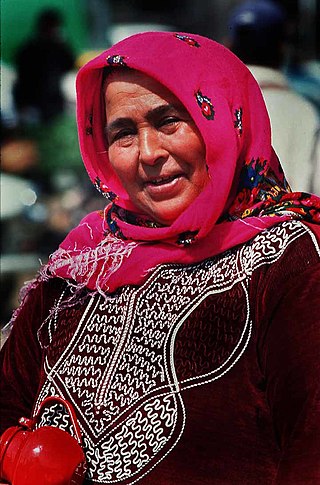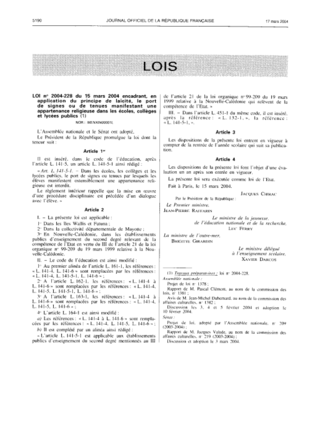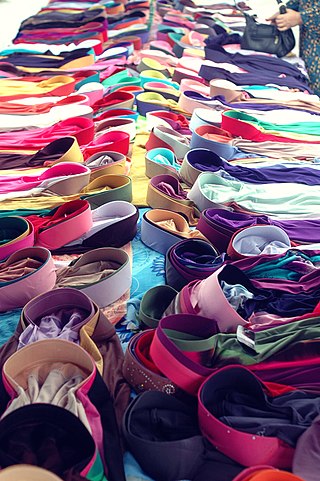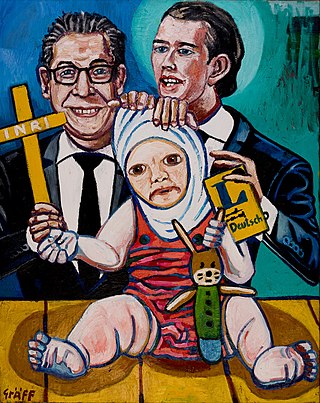
In modern usage, hijab generally refers to various head coverings conventionally worn by many Muslim women. It is similar to the tichel or snood worn by Orthodox Jewish women, certain headcoverings worn by some Christian women, such as the mantilla, apostolnik and wimple, and the dupatta worn by many Hindu and Sikh women. Whilst a hijab can come in many forms, it often specifically refers to a scarf wrapped around the head, covering the hair, neck and ears but leaving the face visible. The use of the hijab has been on the rise worldwide since the 1970s and is viewed by many Muslims as expressing modesty and faith; it has also been worn for purposes of adornment. There is a consensus among Islamic religious scholars that covering the head is either required or preferred, though some Muslim scholars and activists point out that it is not mandated.

A burqa or a burka is an enveloping outer garment worn by some Muslim women which fully covers the body and the face. Also known as a chadaree or chaadar in Afghanistan and Pakistan, or a paranja in Central Asia, the Arab version of the burqa is called the boshiya and is usually black. The term burqa is sometimes conflated with the niqāb even though, in more precise usage, the niqab is a face veil that leaves the eyes uncovered, while a burqa covers the entire body from the top of the head to the ground, with a mesh screen which only allows the wearer to see in front of her. The burqa should also not be confused with the hijab, a garment which covers the hair, neck and all or part of the chest, but does not cover the face.

The French law on secularity and conspicuous religious symbols in schools bans wearing conspicuous religious symbols in French public primary and secondary schools. The law is an amendment to the French Code of Education that expands principles founded in existing French law, especially the constitutional requirement of laïcité: the separation of state and religious activities.

Laïcité is the constitutional principle of secularism in France. Article 1 of the French Constitution is commonly interpreted as the separation of civil society and religious society. It discourages religious involvement in government affairs, especially in the determination of state policies as well as the recognition of a state religion. It also forbids government involvement in religious affairs, and especially prohibits government influence in the determination of religion, such that it includes a right to the free exercise of religion.
Islamic clothing is clothing that is interpreted as being in accordance with the teachings of Islam. Muslims wear a wide variety of clothing, which is influenced not only by religious considerations, but also by practical, cultural, social, and political factors. In modern times, some Muslims have adopted clothing based on Western traditions, while others wear modern forms of traditional Muslim dress, which over the centuries has typically included long, flowing garments. Besides its practical advantages in the climate of the Middle East, loose-fitting clothing is also generally regarded as conforming to Islamic teachings, which stipulate that body areas which are sexual in nature must be hidden from public view. Traditional dress for Muslim men has typically covered at least the head and the area between the waist and the knees, while women's islamic dress is to conceal the hair and the body from the ankles to the neck. Some Muslim women also cover their face. However, other Muslims believe that the Quran does not mandate that women need to wear a hijab or a burqa.

A niqāb or niqaab, also known as a ruband, is a long garment worn by some Muslim women in order to cover their entire body and face, excluding their eyes. It is an interpretation in Islam of the concept of hijab, and is worn in public and in all other places where a woman may encounter non-mahram men. Most prevalent in the Arabian Peninsula, the niqab is a controversial clothing item in many parts of the world, including in some Muslim-majority countries.

A headscarf is a scarf covering most or all of the top of a person's, usually women's, hair and head, leaving the face uncovered. A headscarf is formed of a triangular cloth or a square cloth folded into a triangle, with which the head is covered.

Fadela Amara is a French feminist and politician, who began her political life as an advocate for women in the impoverished banlieues. She was the Secretary of State for Urban Policies in the conservative Union for a Popular Movement (UMP) government of French Prime Minister François Fillon. She is a former president of the organisation Ni Putes Ni Soumises.

The tudong is a style of headscarf, worn as interpretation of the Islamic hijab, prevalent amongst many Muslim women in the Malay-speaking world; Indonesia, Brunei, Malaysia, and Singapore. Today, the tudong forms part of the standard dress code for many offices in Indonesia and Malaysia, as well as in school uniforms and formal occasions. Though initially considered a conservative form of dress, it is worn today by most moderate Muslim women in Malaysia and Indonesia.

The British debate over veils began in October 2006 when the MP and government minister Jack Straw wrote in his local newspaper, the Lancashire Evening Telegraph, that, while he did not want to be "prescriptive", he preferred talking to women who did not wear a niqab as he could see their face, and asked women who were wearing such items to remove them when they spoke to him, making clear that they could decline his request and that a female member of staff was in the room.
Hijab and burka controversies in Europe revolve around the variety of headdresses worn by Muslim women, which have become prominent symbols of the presence of Islam in especially Western Europe. In several countries, the adherence to hijab has led to political controversies and proposals for a legal partial or full ban in some or all circumstances. Some countries already have laws banning the wearing of masks in public, which can be applied to veils that conceal the face. Other countries are debating similar legislation, or have more limited prohibitions. Some of them apply only to face-covering clothing such as the burqa, boushiya, or niqab; some apply to any clothing with an Islamic religious symbolism such as the khimar, a type of headscarf. The issue has different names in different countries, and "the veil" or hijab may be used as general terms for the debate, representing more than just the veil itself, or the concept of modesty embodied in Hijab.

In Turkey, secularism or laicism was first introduced with the 1928 amendment of the Constitution of 1924, which removed the provision declaring that the "Religion of the State is Islam", and with the later reforms of Turkey's first president Mustafa Kemal Atatürk, which set the administrative and political requirements to create a modern, democratic, secular state, aligned with Kemalism.

A burkini is a style of swimsuit for women. The suit covers the whole body except the face, the hands, and the feet, while being light enough for swimming. This type of swimwear was designed with the intention of creating swimwear for Muslims who observe hijab in this way. The amount of skin covered is about the same as the person wearing a wetsuit and a swimming cap.

The headscarf controversy in Turkey was a 20th and early 21st century controversy about women wearing Islamic headscarves. The Republic of Turkey had been a secular state since the constitutional amendment of 1937. Mustafa Kemal Atatürk introduced the secularization of the state in the Turkish Constitution of 1924, alongside his reforms. Over 90% of Turkey's population is Muslim, and the suppression of hijab/headscarves and other prominent religious symbols in government institutions and public schools, led to heated controversy at times in Turkey. Specifically, it resulted in a clash between those favoring the secular principles of the state, such as the Turkish Armed Forces, and religious conservatives, including Islamists. In the early 21st century, the Justice and Development Party (AKP) and its leader Recep Tayyip Erdoğan reversed this, and worked to "raise a pious generation" in Turkey.

Various styles of head coverings, most notably the khimar, hijab, chador, niqab, paranja, yashmak, tudong, shayla, safseri, carşaf, haik, dupatta, boshiya and burqa, are worn by Muslim women around the world, where the practice varies from mandatory to optional or restricted in different majority Muslim and non-Muslim countries.
The French ban on face covering is an act of parliament passed by the Senate of France on 14 September 2010, resulting in the ban on the wearing of face-covering headgear, including masks, helmets, balaclavas, niqābs and other veils covering the face in public places, except under specified circumstances. This ban does not apply to the hijab, as it does not cover the face. The ban also applies to the burqa, a full-body covering, if it covers the face. Consequently, full body costumes and zentais were banned. The bill had previously been passed by the National Assembly of France on 13 July 2010. In April 2011, France became the first European country to impose a ban on full-face veils in public areas.

Hijabophobia is a type of religious and cultural discrimination against Muslim women who wear the hijab. The discrimination has had manifestations in public, working and educational places.
Maryam Pougetoux is a French activist and student union leader. Pougetoux is a current Vice-President of Unef, the National Union of Students of France. Pougetoux was previously the president of the UNEF section of the Sorbonne. Pougetoux was raised in the Paris suburbs by her parents, converts to Islam who originated from the Correze department of southwestern France.

The burqa is worn by women in various countries. Some countries have banned it in government offices, schools, or in public places and streets.
After the Arab conquest of Iran in the 7th century, Islam became the dominant religion and culture in the country. Since then Iranian women adopted the hijab, which was a simple scarf that covered the hair and neck, but not the face. Hijab was seen as a symbol of piety, dignity, and identity for Muslim women.















